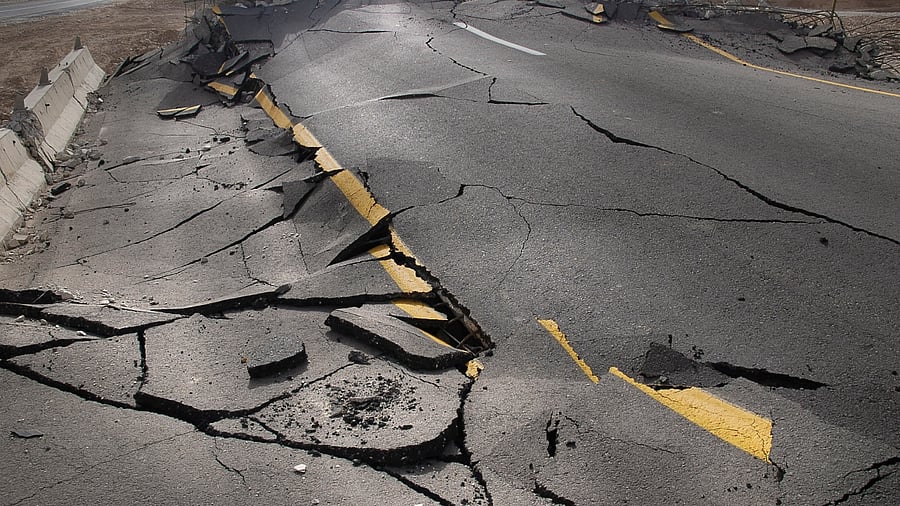
The pre-dawn quake in Turkey and Syria that left 42,000 people dead, injured tens of thousands, and rendered many more homeless in subzero temperatures has been ground-shaking in more ways than one.
It wouldn't be hyperbole to say that from the catastrophic rubble has risen questions for India as well—how prone is India to seismic hazards? How's the state of readiness to meet them, and are building codes strictly enforced?
The Indian terrain is equally prone to great earthquakes, more so since the political boundaries of our country roughly follow the tectonic divides in the west, the north and the east, says CP Rajendran, Professor, National Institute of Advanced Studies, Bengaluru.
"One of our major concerns now should be the 2,500-km-long Himalayan plate boundary, which extends from the northwest to the northeast, in a zone with the potential for large quakes (magnitude 7 and above)," he says.
India is divided into Seismic Zone II, Zone III, Zone IV and Zone V with the latter having the highest risk of damaging earthquakes. The government had, in fact, informed that "...a total of 59 per cent of the land mass of India is prone to earthquakes of different intensities."
Scientists are aware of identifiable gaps along the Himalayan axis where the historical release of geological tension doesn’t fully account for the strain that has built up, Rajendran says.
"For instance, the Central Himalaya has been historically deficient in earthquakes compared to other areas. So it’s one region that can reasonably be expected to generate a large earthquake in the future," he adds.
States like Gujarat, Uttarakhand, Himachal Pradesh, Bihar and the northeastern states fall under Zone V. In such a scenario, how prepared is the country to meet earthquakes of a huge magnitude?
India’s preparedness to deal with earthquakes is dismal, says K M Singh, IPS (Retd), Founder Member, National Disaster Management Authority (NDMA), said. Singh cites multiple reasons for this.
Although the National Building Code 2016 (NBC) contains specific provisions for earthquake-resistant design and construction, there is no mechanism or legal provision for its implementation, he says.
"There is a lack of awareness relating to the provisions of the NBC at all levels, including municipal authorities, concerned agencies of the state governments, architects, builders, construction companies and people in general."
He says while the National Building Code in India has stringent rules and regulations related to constructing safer buildings, the use of poor construction materials often results in violations of the NBC.
There is also a tendency to save money by all stakeholders, including owners, as earthquake-resistant construction adds to the cost of construction, Singh adds. People end up paying with their lives and property when there is an absolute disregard for the laws during construction of buildings, infrastructure etc.
Singh further elaborates on other reasons for dismal preparedness—approval by the government to add additional floors in existing buildings without a certification which says that the foundation of the existing building is designed to bear such additional load, absence of any authorised agency to assess and advise the owners in Seismic Zones III, IV and V on whether their buildings are earthquake-resistant, and non-availability of trained professionals or agencies in retrofitting fragile buildings.
Clearly, the importance of preparedness and mitigation services cannot be emphasised enough if casualties have to be prevented when seismic hazards happen.
"The implementation of National Cyclone Risk Mitigation Project (NCRMP) in the states on east coast, particularly Odisha and Andhra Pradesh, has been responsible for almost zero casualty situation following serious cyclones. On similar lines, a National Earthquake Risk Mitigation (NERMP) Project in seismic vulnerable states is called for," Singh asserts.
The Indian Army and the National Disaster Response Force (NDRF) have so far been playing an incredible role in the rescue and relief operations. But Singh says though the NDRF has acquired requisite expertise as per international standards to deal with any natural disaster and man-made disasters like Chemical, Biological, Radiological, and Nuclear (CBRN) emergencies etc, it needs training infrastructure of international standards, constant upgradation of its equipment, quick mobility with dedicated aircraft, and greater exposure of its personnel, particularly trainers, in training abroad.
'Prediction' of earthquakes
Earthquakes come without warning, so how helpful are early warning systems and hazard maps? And can earthquakes be predicted?
According to the United States Geological Survey (USGS), it takes three things to produce a really useful earthquake prediction—the location where it will happen, when it will happen, and how big the event will be. So far, no one has done it with any certainty, Rajendran says.
"The early warning systems don't predict the earthquakes, but instrumentally detect the ground motion waves from the source, send out alerts to the nearby cities through fast communication systems and provide a few valuable seconds for the residents to run out of their buildings," he explains, adding that at present, we have to depend on earthquake hazard maps and that India also has one which tells one the probability of earthquakes and the maximum magnitude that you expect in different areas.
"But scientists are now currently using Artificial Intelligence and machine-learning techniques to look at the earthquake patterns and see if such techniques can be useful for earthquake prediction," he adds.

